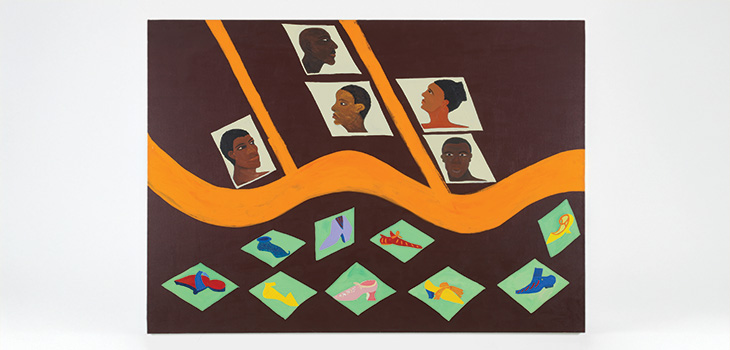*/

In 1985, a time in Britain described by one of the artists in this exhibition as a grey landscape where ginger and garlic were hard to come by, 11 Black women artists came to together in Lubaina Himid’s groundbreaking show at the Institute of Contemporary Arts (ICA), The Thin Black Line. The original exhibition emerged from the early 1980s British Black Arts Movement, when a generation of young Black and Asian women artists demanded space in galleries that had systematically excluded them. Himid’s vision as a curator positioned their works at the centre of critical debates about race, gender and artistic practice and the show established these artists as essential contributors to British cultural discourse. Exhibition participant Sonia Boyce described the show as ‘bold’ as Black women artists ‘were stridently making our presence apparent in the arts’ and bold ‘conceptually and stylistically’.
Moving forwards 40 years, this 2025 iteration of the show, again at the ICA, demonstrates how artistic networks sustain and transform over time. This is not a nostalgic retrospective and Himid presents a dynamic conversation between past and present. For example, mixed-media artist Chila Kumari Burman’s new neon works dazzle the ICA’s concourse with a blend of pop imagery and symbolism which explores her cultural identity, while Marlene Smith’s sculpture, inspired by family photographs of her Windrush parents, reflect the exhibition notes that in the present day, ‘bigotry has been emboldened’. These new commissions sit alongside works spanning four decades, from Sonia Boyce’s early Rice n Peas (1982) to Veronica Ryan’s recent hanging crochet sculpture Threads (2024).
The exhibition reveals the interconnected nature of these artistic practices. Claudette Johnson’s Trilogy series, depicting Black female sitters including fellow exhibition participants Brenda Agard and Ingrid Pollard (asking her subject to ‘stand in a way that allowed her to occupy as much space as possible’), shows how these artists became both creators and subjects within each other’s work. This extends to Himid’s personal collection, which features works by Boyce, Pollard and Maud Sulter, illustrating the bonds forged through shared struggle and mutual support.
The exhibition links artistic practice to broader questions of British identity and belonging. Ingrid Pollard’s landscape photography explores constructions of Britishness and racial difference, while Sutapa Biswas’s photographs from her 2021 Lumen series continues her exploration of colonial history and its impact on individuals. Jennifer Comrie’s pastel drawings bridge figurative art and abstraction, embodying what she describes as ‘the cry within her and the Black community’.
Contemporaneous correspondence displayed in the exhibition reveals the institutional barriers faced when the 1985 exhibition was first conceived, providing an insight into the mechanics of cultural change. Himid, however, notes that many Black women artists remained ‘quite invisible’ over the following decades, that ‘progress took so long to bear fruit’ and those with the power to advance exposure for them, often failed to do so.
This thoughtful exhibition succeeds in demonstrating how The Thin Black Line artists attempted to transform British visual culture and to provide a ladder for subsequent generations while continuing to produce vital and challenging work. The accompanying programme of films, talks and performances fulfils Himid’s original ambition for a multi-disciplinary Black arts festival.
Most significantly, Connecting Thin Black Lines reveals how groups of artists can sustain themselves across decades and how the fight for representation remains as urgent today as it was 40 years ago.

In 1985, a time in Britain described by one of the artists in this exhibition as a grey landscape where ginger and garlic were hard to come by, 11 Black women artists came to together in Lubaina Himid’s groundbreaking show at the Institute of Contemporary Arts (ICA), The Thin Black Line. The original exhibition emerged from the early 1980s British Black Arts Movement, when a generation of young Black and Asian women artists demanded space in galleries that had systematically excluded them. Himid’s vision as a curator positioned their works at the centre of critical debates about race, gender and artistic practice and the show established these artists as essential contributors to British cultural discourse. Exhibition participant Sonia Boyce described the show as ‘bold’ as Black women artists ‘were stridently making our presence apparent in the arts’ and bold ‘conceptually and stylistically’.
Moving forwards 40 years, this 2025 iteration of the show, again at the ICA, demonstrates how artistic networks sustain and transform over time. This is not a nostalgic retrospective and Himid presents a dynamic conversation between past and present. For example, mixed-media artist Chila Kumari Burman’s new neon works dazzle the ICA’s concourse with a blend of pop imagery and symbolism which explores her cultural identity, while Marlene Smith’s sculpture, inspired by family photographs of her Windrush parents, reflect the exhibition notes that in the present day, ‘bigotry has been emboldened’. These new commissions sit alongside works spanning four decades, from Sonia Boyce’s early Rice n Peas (1982) to Veronica Ryan’s recent hanging crochet sculpture Threads (2024).
The exhibition reveals the interconnected nature of these artistic practices. Claudette Johnson’s Trilogy series, depicting Black female sitters including fellow exhibition participants Brenda Agard and Ingrid Pollard (asking her subject to ‘stand in a way that allowed her to occupy as much space as possible’), shows how these artists became both creators and subjects within each other’s work. This extends to Himid’s personal collection, which features works by Boyce, Pollard and Maud Sulter, illustrating the bonds forged through shared struggle and mutual support.
The exhibition links artistic practice to broader questions of British identity and belonging. Ingrid Pollard’s landscape photography explores constructions of Britishness and racial difference, while Sutapa Biswas’s photographs from her 2021 Lumen series continues her exploration of colonial history and its impact on individuals. Jennifer Comrie’s pastel drawings bridge figurative art and abstraction, embodying what she describes as ‘the cry within her and the Black community’.
Contemporaneous correspondence displayed in the exhibition reveals the institutional barriers faced when the 1985 exhibition was first conceived, providing an insight into the mechanics of cultural change. Himid, however, notes that many Black women artists remained ‘quite invisible’ over the following decades, that ‘progress took so long to bear fruit’ and those with the power to advance exposure for them, often failed to do so.
This thoughtful exhibition succeeds in demonstrating how The Thin Black Line artists attempted to transform British visual culture and to provide a ladder for subsequent generations while continuing to produce vital and challenging work. The accompanying programme of films, talks and performances fulfils Himid’s original ambition for a multi-disciplinary Black arts festival.
Most significantly, Connecting Thin Black Lines reveals how groups of artists can sustain themselves across decades and how the fight for representation remains as urgent today as it was 40 years ago.


Chair of the Bar reflects on 2025
AlphaBiolabs has donated £500 to The Christie Charity through its Giving Back initiative, helping to support cancer care, treatment and research across Greater Manchester, Cheshire and further afield
Q&A with criminal barrister Nick Murphy, who moved to New Park Court Chambers on the North Eastern Circuit in search of a better work-life balance
Revolt Cycling in Holborn, London’s first sustainable fitness studio, invites barristers to join the revolution – turning pedal power into clean energy
Rachel Davenport, Co-founder and Director at AlphaBiolabs, reflects on how the company’s Giving Back ethos continues to make a difference to communities across the UK
By Marie Law, Director of Toxicology at AlphaBiolabs
Are you ready for the new way to do tax returns? David Southern KC explains the biggest change since HMRC launched self-assessment more than 30 years ago... and its impact on the Bar
Professor Dominic Regan and Seán Jones KC present their best buys for this holiday season
Oscar Davies shares their lessons learnt
Little has changed since Burns v Burns . Cohabiting couples deserve better than to be left on the blasted heath with the existing witch’s brew for another four decades, argues Christopher Stirling
Pointillism, radical politics and social conscience. Review by Stephen Cragg KC